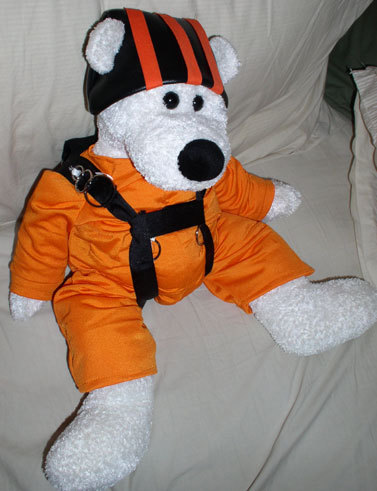QuoteDo you think you have any credibility without filling your profile, Mr Pornstart?
You can check The Ranch DZ for his credibility rating.
Sparky
My idea of a fair fight is clubbing baby seals
QuoteI disagree about PLF's not being good for high speed horizontal landings. We used to jump rounds a lot on windy days. Some of those landings were in excess of twenty MPH. Knowing how to do a really good PLF is what saved me on those jumps
Windy days on rounds you go backwards. Not part of the jump I relished, but I could deal with it. It was zero winds that were the problem, hence this whole discussion of forward PLFs. I remember them on rounds on nil-wind days. It sucked, big time
I'd love to take an optional course at a DZ on various ways of falling forward under hairy conditions. If skydivers could take a few tips from legends like The Clawmaster, The Undertaker or Rick Flair, why not?
I wouldn't have students do this, though. I can't imagine the forward speed of a Manta can ever be that great. It might be useful for people who are working on their landing skills under faster canopies. The consolation of a mucked up swoop would be a gymnastic double flip somersault. We could have Wuffos equipped with scorecards giving marks out of 10
"where danger is appears also that which saves ..." Friedrich Holderlin, 'Patmos'
steve1 5
Windy days on rounds you go backwards. Not part of the jump I relished, but I could deal with it. It was zero winds that were the problem, hence this whole discussion of forward PLFs. I remember them on rounds on nil-wind days. It sucked, big time 
I'd love to take an optional course at a DZ on various ways of falling forward under hairy conditions. If skydivers could take a few tips from legends like The Clawmaster, The Undertaker or Rick Flair, why not?
That's a good point. I've got in the habit of sliding in some landings rather than PLFing or some type of flip. Sliding it in on uneven ground might be a recipe for injury too. So maybe I shouldn't be saying that's the best thing to do.
So that has me thinking about a forward PLF. A forward PLF works great as long as there isn't a lot of speed built up. It's really hard to twist to your side fast enough to do one if you're going a 100 mph under a hot canopy on a calm day. Same thing with a rear PLF. I could never spin to my side fast enough on high wind days under a rag, so I would face slightly cross wind just so I could do a good PLF.
Coming in really fast under a little canopy, may again be really hard to PLF. (I guess I finally do get the point!) So if sliding is out...maybe some type of roll could be used. I think this might be disasterous though, if done incorrectly. I'd sure hate to land, feet, face, then back. Maybe Hay Stack Calhoon could do it in the ring, but I'm not so sure an old fart like me could do it.
I know on windy days (on rounds) you are supposed to be going backward on landing. When I first started jumping in the army our T-10's had no modification at all. You'd pull down on your risers and slip (very slightly) into the wind. So it was possible to have a very fast forward PLF eve if the wind was blowing hard. That is probably the reason we spent so much time learning a forward PLF in jump school.....Steve1
I'd love to take an optional course at a DZ on various ways of falling forward under hairy conditions. If skydivers could take a few tips from legends like The Clawmaster, The Undertaker or Rick Flair, why not?
That's a good point. I've got in the habit of sliding in some landings rather than PLFing or some type of flip. Sliding it in on uneven ground might be a recipe for injury too. So maybe I shouldn't be saying that's the best thing to do.
So that has me thinking about a forward PLF. A forward PLF works great as long as there isn't a lot of speed built up. It's really hard to twist to your side fast enough to do one if you're going a 100 mph under a hot canopy on a calm day. Same thing with a rear PLF. I could never spin to my side fast enough on high wind days under a rag, so I would face slightly cross wind just so I could do a good PLF.
Coming in really fast under a little canopy, may again be really hard to PLF. (I guess I finally do get the point!) So if sliding is out...maybe some type of roll could be used. I think this might be disasterous though, if done incorrectly. I'd sure hate to land, feet, face, then back. Maybe Hay Stack Calhoon could do it in the ring, but I'm not so sure an old fart like me could do it.
I know on windy days (on rounds) you are supposed to be going backward on landing. When I first started jumping in the army our T-10's had no modification at all. You'd pull down on your risers and slip (very slightly) into the wind. So it was possible to have a very fast forward PLF eve if the wind was blowing hard. That is probably the reason we spent so much time learning a forward PLF in jump school.....Steve1
Would swooping be more exciting if you had to duck a clothesline? It would look great on video if you didnt duck in time.
The fact that I want to get enough jumps so i can start videoing some of this stuff safely is pretty absurd.
TV's got them images, TV's got them all, nothing's shocking.
The fact that I want to get enough jumps so i can start videoing some of this stuff safely is pretty absurd.
TV's got them images, TV's got them all, nothing's shocking.
bob.dino 0
QuoteWould swooping be more exciting if you had to duck a clothesline?
What about the parachute? Does it have to duck too?





I disagree about PLF's not being good for high speed horizontal landings. We used to jump rounds a lot on windy days. Some of those landings were in excess of twenty MPH. Knowing how to do a really good PLF is what saved me on those jumps.
I wonder if new jumpers get enough training in how to do a proper PLF these days. Even new jumpers in the 70's got a minimal amount of training in PLF's. Jumping off a table a few times isn't enough.
I believe the army airborne school has the best PLF training to be found anywhere. Back in the olden days they used a swing land trainer. (I think it's still used at Ft. Benning today.) After stepping off an elevated platform you would swing back and forth several times and then your instructor would drop you into the ground. You practiced this over and over from different angles. You would hit feet and knees together, twist to your side (keeping your elbows in) (chin tucked to your chest) and then flip over on the back of your shoulders.
I believe this is a very valuable technique to learn. In Jump School you spend two weeks practicing these until you could do them perfect from every direction.
I'd like to say I never hit my head. I remember a lot of rear PLF's where I couldn't spin to my side fast enough and did just that. Some of these landings were more feet, rear, and head landings. Noone jumped without a heavy duty helmet back then. I learned some other methods of getting to my side with more experience. But I still relied on doing a basic PLF.
As far as sliding in a modern canopy, I think this works quite well. Maybe they aren't the best for all conditions but I did a lot of them this past summer. My ankle was severely messed up due to a low turn and I had a hard time walking let alone running out a landing. On windless mornings at Lost Prairie, I slid in almost every landing. Mad John was doing the same thing. (I noticed he had a limp this year too.)
So again your method might work better for you, but I'm going to stick with PLF's. It's just too hard to teach an old dog new tricks....Steve1
Share this post
Link to post
Share on other sites